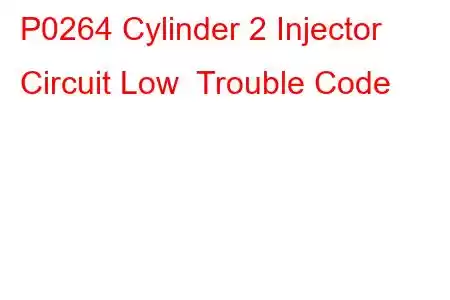P0264 Cylinder 2 Injector Circuit Low
OBD-II Trouble Code Technical Description
Cylinder #2 Injector Circuit Low
What does that mean?
The OBD trouble code P0264 is a generic powertrain code common to all vehicles. Although the code's reference is the same, the repair procedure may vary somewhat with the manufacturer.
This code implies that the powertrain control module (PCM) has experienced a low voltage situation involving the fuel injector for the #2 cylinder in the firing order.
In short, this fuel injector is malfunctioning for one of a variety of reasons. It is important to diagnose and repair this type of problem as soon as possible.
When a fuel injector malfunctions, it causes ripples down the line, meaning the engine's operating parameters change due to the mixed signals at the PCM.
If the fuel injector spray pattern is reduced, a lean mixture will result. The ripple begins. The oxygen sensor signals a lean mixture to the PCM. In response, it richens the fuel mixture to all cylinders. Fuel economy plummets.
The cylinder with the faulty injector causes a lean mixture that in turn causes a higher cylinder head temperature resulting in detonation. The knock sensor senses the detonation, signals the PCM which responds by retarding the timing. Now the engine is running rough and lacks power.
This is not the end of the ripple effect, but it reflects the general idea.
Cross-section diagram of a typical automotive fuel injector (provided by WikipedianProlific):
Symptoms
The symptoms displayed for a P0264 code may include:
The check engine light will illuminate and code P0264 will set The engine will run rougher than normal A lack of power A big drop in fuel economy will resultCauses
Possible causes for this DTC include:
Dirty fuel injector supplying the number two cylinder Faulty fuel injector Plugged fuel injector Open or short in the fuel injector harness Loose or corroded fuel injector connectorDiagnosis / Repair
Generally, this type of problem is either a loose or corroded electrical connector on the injector, a fouled injector (dirty or plugged) or a bad injector needing replacement.
In over 45 years I have found that loose or corroded connectors were the cause of the electrical fault the majority of the time. I have found but a few cases where low voltage wiring became shorted or open (when left undisturbed).
The majority of electrical problems were alternator related, starter solenoid wiring, oxygen sensor wiring due to the close proximity to the exhaust and battery related. The majority of electrical work was correcting customer-installed items such as high-power stereos and other parts or equipment installed incorrectly.
The fuel injectors get their power from the fuel pump relay. The PCM actuates the relay as the key is turned on. This means, as long as the key is on, the injectors have power.
The PCM activates the injector by supplying the ground at the necessary time and for the proper duration.
Check the connector on the fuel injector. It is a plastic connector secured to the injector with a wire clip around the connector. Pull on the connector to see if it comes off easily. Remove the wire clip and pull the connector off the injector. Inspect the harness connector for corrosion or pushed out pins. Make sure the two blades are not bent in the injector itself. Correct any defect and apply dielectric grease and install the electrical connector. Start the engine and listen to the injector to ensure it is working. Use a long screwdriver to the injector and the handle to your ear and you can hear it clearly. If it isn't making a highly audible 'clicking' noise, it either has no electrical power to it or it has failed. If it was not clicking, pull the connector off the injector and check for power with a voltmeter.Read: 48


